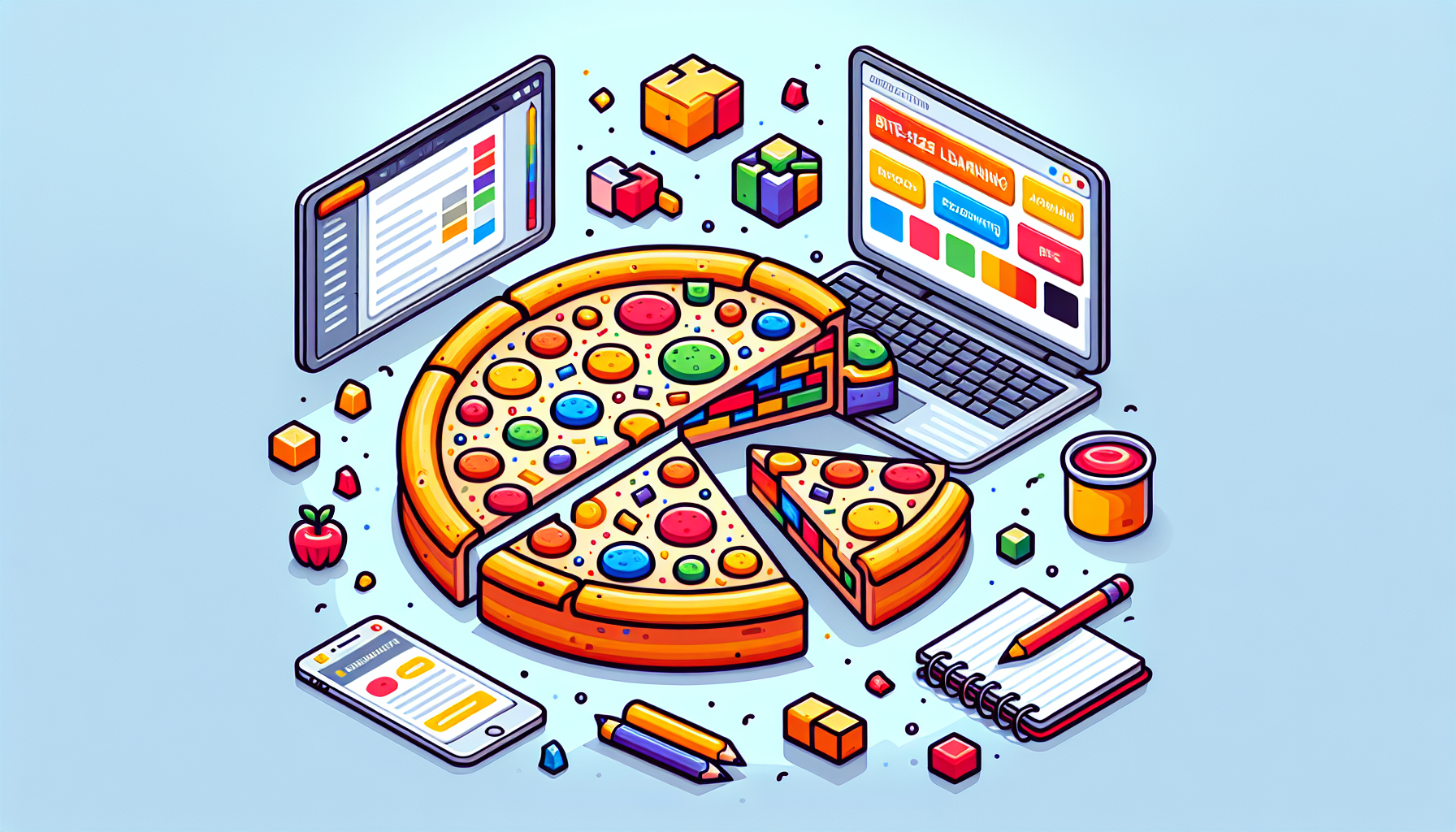We all know how overwhelming it can be to tackle long eLearning courses. It feels like trying to eat a giant pizza all at once—definitely not appealing! Many learners struggle to stay engaged when faced with lengthy content, and that’s totally understandable. Bite-sized modules can be the secret sauce to making learning a lot more manageable and enjoyable.
But guess what? If you hang in there, I’ll share some great tips on delivering eLearning content in those easy-to-digest bites. You’ll learn how to keep your audience engaged and coming back for more, without the customary learning burnout.
From exploring the benefits of bite-sized learning to handy tools and best practices, you’ll discover everything you need to create impactful modules. Plus, I’ll throw in some real-life success stories to inspire your journey!
Key Takeaways
- Break content into bite-sized modules for better engagement and retention.
- Focus on key concepts, keeping each module concise—aim for 5 to 10 minutes.
- Use multimedia elements and interactive quizzes to enhance learning.
- Make your delivery platform user-friendly and accessible on all devices.
- Regularly review and update content based on learner feedback and performance metrics.
- Utilize tools like LMS platforms to track learner engagement and progress.
- Encourage ongoing feedback to adapt modules to learners’ needs effectively.

How to Deliver eLearning Content in Bite-Sized Modules
Delivering eLearning content in bite-sized modules is all about breaking down information into smaller, manageable chunks.
This approach helps learners absorb material without feeling overwhelmed.
Start by identifying the key concepts you want to convey and then divide those into distinct topics.
Using clear headings for each module can also improve navigation.
Don’t forget to incorporate a multimedia aspect with videos or infographics to keep things engaging.
Interactive elements like quizzes can also enhance understanding and retention.
Lastly, consider the pacing—allow learners to progress at their own rate to encourage deeper learning.
Benefits of Bite-Sized Learning Modules
Bite-sized learning modules offer multiple benefits for both learners and educators.
First and foremost, they improve retention rates; studies show that learners can recall information more easily when it’s presented in smaller doses.
This format is also more flexible, allowing learners to engage with content on their own schedule.
Moreover, when individuals complete a short module, it creates a sense of accomplishment that encourages them to continue.
Employers appreciate bite-sized learning too, as it can lead to immediate application of skills in the workplace.
Additionally, these modules are often more cost-effective to produce than lengthy, traditional courses.
By utilizing tools for microlearning, organizations can reduce their training costs while still providing high-quality educational content.
Steps to Create Effective Bite-Sized Content
Creating effective bite-sized content involves a few clear steps to ensure maximum impact.
First, conduct a needs assessment to determine what learners need to know.
Next, outline your content strategy, focusing on key learning objectives.
Break down complex information into simple concepts, making each module concise—around five to ten minutes is a great target.
Incorporate engaging elements, like scenarios or real-world examples, to illustrate concepts.
Review and revise your content to eliminate fluff—each word should serve a purpose.
Finally, pilot your modules with a test group to gather feedback, allowing for adjustments before the full rollout.
Best Practices for Delivering eLearning Modules
When it comes to delivering eLearning modules, several best practices can help you achieve a successful learning environment.
First, ensure that your delivery platform is user-friendly and accessible across devices.
Offer a variety of learning formats, like videos, articles, and interactive quizzes, to cater to different learning styles.
Incorporate spaced repetition; revisiting key concepts over time helps reinforce memory.
Keep communication open by providing channels for learners to ask questions or share feedback.
Lastly, regularly update your content to keep it relevant and engaging, reflecting any new developments in your subject area.
Applying these strategies will not only enhance the learning experience but also keep learners coming back for more.

Tools and Platforms for Bite-Sized Learning
Choosing the right tools and platforms is crucial for delivering bite-sized learning effectively.
Consider using Learning Management Systems (LMS) like Teachable or Thinkific that allow you to create and manage your course content easily.
These platforms often have built-in analytics to track learner progress and engagement.
Also, tools like Adobe Captivate and Articulate 360 enable you to create interactive and engaging content.
For video content, consider solutions like Vimeo or YouTube to host your material.
Remember, mobile compatibility is key, so make sure your tools support responsive design to reach learners on any device.
Incorporating these tools will streamline your process and enhance the learner’s experience.
Measuring the Effectiveness of Bite-Sized Learning
Evaluating the effectiveness of bite-sized learning is essential to ensure it meets your educational goals.
Start by setting clear KPIs (Key Performance Indicators) like completion rates, quiz scores, and learner feedback.
Use survey tools or polls after each module to gauge understanding and satisfaction.
Analytics from your LMS can provide insights into how learners engage with the content.
If a specific module has a low completion rate, that’s a red flag—it may need revising.
Encouraging ongoing feedback will help you fine-tune your content and adapt to your learners’ needs.
Regularly review this data to make informed decisions about updates or improvements to your materials.

Case Studies of Successful Bite-Sized eLearning
Looking at real-world examples can offer valuable insights into how bite-sized learning can be effective.
For instance, a large healthcare organization developed short, interactive modules to train staff on compliance and safety procedures.
These modules cut training time by 50% while improving retention rates significantly according to post-training assessments.
Another example comes from a tech company that utilized microlearning for onboarding new hires.
By offering brief, focused sessions on company culture, products, and job functions, they reported a 30% increase in new employee satisfaction.
Additionally, a school district implemented bite-sized learning in their curriculum, engaging students with short video lessons followed by quizzes.
The outcome was a notable improvement in student performance, proving that this method can resonate well in educational settings.
By studying these cases, it’s clear that bite-sized modules can adapt across various fields and lead to successful outcomes.
Future Trends in Bite-Sized Learning
The landscape of bite-sized learning continues to evolve, shaped by technology and learner preferences.
One exciting trend is the increasing use of artificial intelligence to personalize learning experiences.
AI can analyze individual learner behavior, tailoring content to fit their needs and learning paces.
Another trend is the integration of augmented reality (AR) and virtual reality (VR) for immersive microlearning experiences.
This could enable learners to participate in realistic simulations, enhancing skill acquisition through practical engagement.
We’re also seeing a growth in mobile learning, with many learners preferring to access content on-the-go.
This shift emphasizes the need for responsive design in learning platforms to ensure accessibility on various devices.
Lastly, community-based learning is gaining traction, where learners can collaborate and support each other in bite-sized formats.
As we look ahead, these trends will likely shape the way bite-sized learning is delivered and experienced.
FAQs
Bite-sized learning modules are short, focused units of educational content designed to deliver knowledge in manageable segments. This approach enhances retention and allows learners to absorb information without feeling overwhelmed.
The benefits include improved retention and engagement, flexibility in learning pace, and easier content updates. Bite-sized learning accommodates different learning styles and enables learners to fit training into their busy schedules.
Create effective bite-sized content by defining learning objectives, keeping modules concise, incorporating multimedia elements, and fostering interactivity. Structure content for logical flow and ensure it aligns with overall training goals for maximum impact.
Popular tools for bite-sized learning include Learning Management Systems (LMS) like Moodle or TalentLMS, microlearning platforms such as EdApp, and content creation tools like Articulate Storyline and Adobe Captivate for engaging module design.
